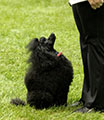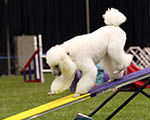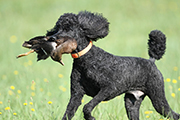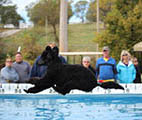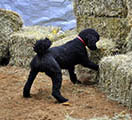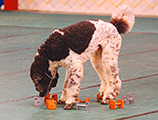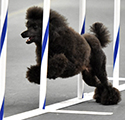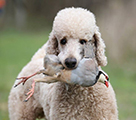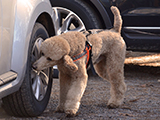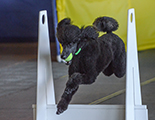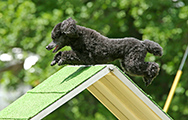Growing a Show Coat on the Working Poodle
Many owners feel they must delay training for obedience, tracking, or agility until their Poodle has completed its championship because of the fear of ruining show coat. With the advances made in training methods, collar protectors and coat products, there is no reason to delay training. In fact, an obedience trained dog is an asset in the conformation ring. But, you may ask, what about the show coat?
Growing coat is an attitude. That attitude is that the hair is made of precious gold and must be protected at all times. It takes a certain commitment to keep show coat on a working Poodle, especially if the Poodle is active in field work or tracking.
The procedure for keeping show coat is the same on both puppies and adults.
Brush the coat with a pin brush or a properly-used slicker brush. To use a slicker brush properly, gently work from the ends out first, being certain there are no mats or small tangles. If there are, work the mats out with your fingers by gently pulling the tangled hair apart. You want to lose the least amount of hair possible. There should be no sound when using a slicker brush. If you hear sound then the slicker is hitting a mat. Stop, find the mat, work on getting it out of the coat then begin brushing again. It will help to lightly mist the area of coat you are working on with either a good conditioning spray or light oil. Some products you might try are The Stuff, Ring 5 Mink Oil, properly diluted Royal Crown conditioner # 38, Alpha Keri or generic equivalent bath oil diluted 1-2 teaspoon per quart of water. Using an oil spray is called keeping the coat in light oil and should help to reduce matting significantly. The use of a dryer on cool setting to separate the hair will make the skin more visible.
Once the hair is clear of mats or tangles, start at the skin and brush in a smooth straight motion to the end of the hair. Using a slicker brush and seeing the skin ensures the “felt” (dead hair) at skin level is not building up. Buildup of felt at the skin can cause matting and be painful to the dog. Using a slicker brush will straighten the coat more thoroughly than a pin brush on Poodles with very curly coat textures, or those who are wet frequently. Some prefer to use a slicker brush on the body and a pin brush for the neck, topknot and ears. Brush often enough to train the dog to lie flat on his side on the table and enjoy grooming.
Every time you pass a brush or comb through a coat you are contributing to the wear of the hair shaft. Hair grows from the root. After a hair emerges from the hair follicle, that hair diameter and texture is fixed. It only grows in length. Every time a hair is touched and rubbed by comb, hands, brush or collar the hair is in the process of wearing out. A worn hair loses texture, elasticity, and strength. Therefore, only brush to keep mats out or to train a dog. Never brush dry hair. Mist the coat with water or a light spray conditioner or oil when brushing to prevent static and breakage. All brushing should be done as line brushing. Separate a thin strip of hair, making sure the hair is parted to the skin. When this bit is brushed, use your hand to separate another inch of hair and brush that area. Develop a routine of starting at one point on the dog then working through the coat until the entire dog is brushed.
Most people recommend you bathe a show coat every 7-10 days. Dirty hair breaks. Dry the hair to prevent tangles that can occur if air drying. Heat will stretch and straighten the hairs. Using a heat dryer is not necessary between shows; a force dryer will remove water quickly with less brushing required.
Puppies change coat somewhere between the ages of 6 and18 months, typically around 9 months of age. (Puppy coat being replaced by adult coat.) Onset and duration of coat change varies due to family lines, variety and, to some extent, coat color and texture. Frequent matting will signal the beginning of coat change. Keep the coat clean. You may need to brush as often as twice daily, or as infrequently as twice weekly, to keep the coat free of mats.
You can also keep a dog in heavy oil by applying an oil and water mixture to the coat after bathing, paying special attention to the areas where the coat rubs, such as the neck, flanks and underarms. Brush and dry the dog as normal. Be aware that Poodles kept in heavy oil will leave oil residue where they lie. Heavy oil is not “insurance” the coat will not mat. Oil plus dirt will create mats. For these reasons, most people no longer use heavy oil. Heavy oil is not recommended except in extreme cases where the coat cannot be brushed for a longer period of time than may be prudent. Using oil prolongs the time it takes the coat to mat.
When you prepare for the conformation ring, you must get the oil out of the coat by using a good canine detergent shampoo, or Dawn dish detergent, and several lathers of a good show shampoo. After the shampoo, use a good quality coat conditioner rinse and allow it to set on the coat for several minutes before a quick water rinse and then a “show blow dry.”
When the show is over, bathe the dog, use a conditioner and blow dry the hair.
Never have a collar on your dog unless you have it in a training situation or the ring. Collars of all types are very destructive to the precious neck hair. When you train, use a nylon or satin “neck gaiter” or snood over which the collar can be placed. Remember, any time your dog has a collar around its neck that neck hair is being worn and broken off.
In tracking training you may put a nylon or satin jumpsuit or tee shirt under the harness on your dog. This protects from foxtails, seeds, weeds, sun and the tracking harness. If ticks are prevalent, you can lightly spray the jumpsuit with a tick repellent to further help save on coat loss by decreasing the number of ticks that get onto the dog. If your jumpsuit is water repellent it is also helpful in saving and protecting coat during the rainy season or deep snow.
You cannot show a Poodle in obedience with coat protective measures in place, but your dog can wear a coat at an AKC tracking test.
It may be possible to hunt with a dog in a neoprene wet suit designed for the dog. It would be very difficult if not impossible to hunt with a dog in a show clip without some type of very innovative protective device.
The information contained in these documents is current at the time of this writing and is accurate to the best of VIP’s knowledge.
This information has been provided to you at no charge. You are free to use it provided it is used in its entirety with no changes or alterations and that the copyright remains intact. If you have found this information to be helpful, please consider making a tax-deductible donation to:
Versatility in Poodles
4061 Highlands Rd
Franklin, NC 28734
To make a donation via PayPal, please click the Donate Button:
The contents of the www.vipoodle.org website, such as text, graphics, images, and other material contained on this site (“Content”) are for informational purposes only. The Content is not intended to be a substitute for professional veterinarian advice, diagnosis, or treatment. Always seek the advice of your veterinarian with any questions you may have regarding the medical condition of your pet. Never disregard professional advice or delay in seeking it because of something you have read on this website!
If you think your pet has a medical emergency, call or visit your veterinarian or your local veterinary emergency hospital immediately. Versatility in Poodles and www.vipoodle.org do not recommend or endorse any specific veterinarians, products, procedures, opinions, or other information that may be mentioned on this website. Reliance on any information appearing on this website is entirely at your own risk.


